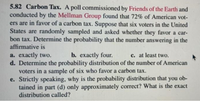
MATLAB: An Introduction with Applications
6th Edition
ISBN: 9781119256830
Author: Amos Gilat
Publisher: John Wiley & Sons Inc
expand_more
expand_more
format_list_bulleted
Question
Please answer parts d and e in he following question given parts a b and c

Transcribed Image Text:**5.82 Carbon Tax**
A poll commissioned by Friends of the Earth and conducted by the Mellman Group found that 72% of American voters are in favor of a carbon tax. Suppose that six voters in the United States are randomly sampled and asked whether they favor a carbon tax. Determine the probability that the number answering in the affirmative is:
a. exactly two.
b. exactly four.
c. at least two.
d. Determine the probability distribution of the number of American voters in a sample of six who favor a carbon tax.
e. Strictly speaking, why is the probability distribution that you obtained in part (d) only approximately correct? What is the exact distribution called?
![**Solution:**
**a) \( P(X = 2) \)**
\[
P(X = 2) = \binom{6}{2} (0.72)^2 (0.28)^{6-2}
\]
\[
= 15 \times 0.5184 \times 0.0061
\]
\[
P(X = 2) = 0.0478
\]
**b) \( P(X = 4) \)**
\[
P(X = 4) = \binom{6}{4} (0.72)^4 (0.28)^{6-4}
\]
\[
= 15 \times 0.2687 \times 0.0784
\]
\[
P(X = 4) = 0.3159
\]
**c) \( P(X \geq 2) \)**
\[
P(X \geq 2) = 1 - P(X < 2)
\]
\[
= 1 - \left[ P(X = 0) + P(X = 1) \right]
\]
\[
= 1 - \left[ \binom{6}{0} (0.72)^0 (0.28)^6 + \binom{6}{1} (0.72)^1 (0.28)^{6-1} \right]
\]
\[
= 1 - \left[ 0.00048 + 0.0074 \right]
\]
\[
= 1 - 0.00788
\]
\[
P(X \geq 2) = 0.9921
\]
**Explanation:**
The solutions provide the calculations for three different probabilities of a binomial distribution:
1. **\( P(X = 2) \)**: The probability of exactly two successes in six trials.
2. **\( P(X = 4) \)**: The probability of exactly four successes in six trials.
3. **\( P(X \geq 2) \)**: The probability of two or more successes in six trials, calculated as one minus the probability of obtaining less than two successes.](https://content.bartleby.com/qna-images/question/281e2029-de70-4b7c-8ebc-bf0179904e66/cba4387d-f997-4930-8619-2c8ffcd96eae/ujabtn_thumbnail.png)
Transcribed Image Text:**Solution:**
**a) \( P(X = 2) \)**
\[
P(X = 2) = \binom{6}{2} (0.72)^2 (0.28)^{6-2}
\]
\[
= 15 \times 0.5184 \times 0.0061
\]
\[
P(X = 2) = 0.0478
\]
**b) \( P(X = 4) \)**
\[
P(X = 4) = \binom{6}{4} (0.72)^4 (0.28)^{6-4}
\]
\[
= 15 \times 0.2687 \times 0.0784
\]
\[
P(X = 4) = 0.3159
\]
**c) \( P(X \geq 2) \)**
\[
P(X \geq 2) = 1 - P(X < 2)
\]
\[
= 1 - \left[ P(X = 0) + P(X = 1) \right]
\]
\[
= 1 - \left[ \binom{6}{0} (0.72)^0 (0.28)^6 + \binom{6}{1} (0.72)^1 (0.28)^{6-1} \right]
\]
\[
= 1 - \left[ 0.00048 + 0.0074 \right]
\]
\[
= 1 - 0.00788
\]
\[
P(X \geq 2) = 0.9921
\]
**Explanation:**
The solutions provide the calculations for three different probabilities of a binomial distribution:
1. **\( P(X = 2) \)**: The probability of exactly two successes in six trials.
2. **\( P(X = 4) \)**: The probability of exactly four successes in six trials.
3. **\( P(X \geq 2) \)**: The probability of two or more successes in six trials, calculated as one minus the probability of obtaining less than two successes.
Expert Solution
This question has been solved!
Explore an expertly crafted, step-by-step solution for a thorough understanding of key concepts.
This is a popular solution
Trending nowThis is a popular solution!
Step by stepSolved in 3 steps with 2 images

Knowledge Booster
Similar questions
- Question 11712 11 Wal-Mart sells juices in boxes of 12 for $3.60 per box. Bartram's sells juices in boxes of 6 for $1.80 per box. Are the two rates equivalent? A Yes B No CImpossible to tell with the given information.arrow_forwardThe answers given are incorrectarrow_forwardQUESTION 29 Add. a. b. 5 d. e. 7 469arrow_forward
arrow_back_ios
arrow_forward_ios
Recommended textbooks for you
 MATLAB: An Introduction with ApplicationsStatisticsISBN:9781119256830Author:Amos GilatPublisher:John Wiley & Sons Inc
MATLAB: An Introduction with ApplicationsStatisticsISBN:9781119256830Author:Amos GilatPublisher:John Wiley & Sons Inc Probability and Statistics for Engineering and th...StatisticsISBN:9781305251809Author:Jay L. DevorePublisher:Cengage Learning
Probability and Statistics for Engineering and th...StatisticsISBN:9781305251809Author:Jay L. DevorePublisher:Cengage Learning Statistics for The Behavioral Sciences (MindTap C...StatisticsISBN:9781305504912Author:Frederick J Gravetter, Larry B. WallnauPublisher:Cengage Learning
Statistics for The Behavioral Sciences (MindTap C...StatisticsISBN:9781305504912Author:Frederick J Gravetter, Larry B. WallnauPublisher:Cengage Learning Elementary Statistics: Picturing the World (7th E...StatisticsISBN:9780134683416Author:Ron Larson, Betsy FarberPublisher:PEARSON
Elementary Statistics: Picturing the World (7th E...StatisticsISBN:9780134683416Author:Ron Larson, Betsy FarberPublisher:PEARSON The Basic Practice of StatisticsStatisticsISBN:9781319042578Author:David S. Moore, William I. Notz, Michael A. FlignerPublisher:W. H. Freeman
The Basic Practice of StatisticsStatisticsISBN:9781319042578Author:David S. Moore, William I. Notz, Michael A. FlignerPublisher:W. H. Freeman Introduction to the Practice of StatisticsStatisticsISBN:9781319013387Author:David S. Moore, George P. McCabe, Bruce A. CraigPublisher:W. H. Freeman
Introduction to the Practice of StatisticsStatisticsISBN:9781319013387Author:David S. Moore, George P. McCabe, Bruce A. CraigPublisher:W. H. Freeman

MATLAB: An Introduction with Applications
Statistics
ISBN:9781119256830
Author:Amos Gilat
Publisher:John Wiley & Sons Inc

Probability and Statistics for Engineering and th...
Statistics
ISBN:9781305251809
Author:Jay L. Devore
Publisher:Cengage Learning

Statistics for The Behavioral Sciences (MindTap C...
Statistics
ISBN:9781305504912
Author:Frederick J Gravetter, Larry B. Wallnau
Publisher:Cengage Learning

Elementary Statistics: Picturing the World (7th E...
Statistics
ISBN:9780134683416
Author:Ron Larson, Betsy Farber
Publisher:PEARSON

The Basic Practice of Statistics
Statistics
ISBN:9781319042578
Author:David S. Moore, William I. Notz, Michael A. Fligner
Publisher:W. H. Freeman

Introduction to the Practice of Statistics
Statistics
ISBN:9781319013387
Author:David S. Moore, George P. McCabe, Bruce A. Craig
Publisher:W. H. Freeman